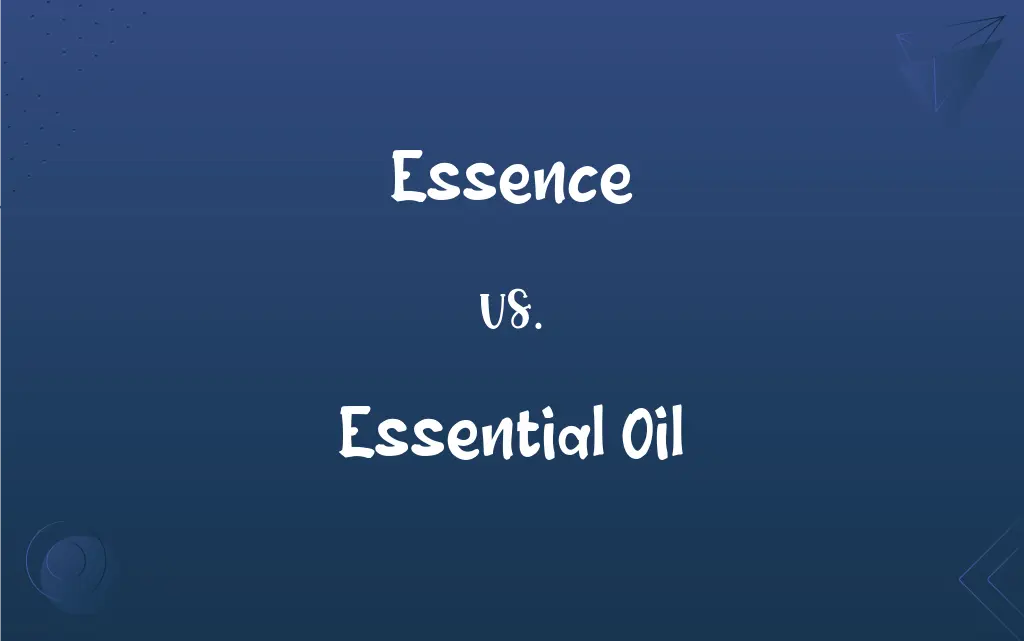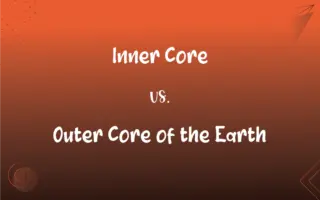Essence vs. Essential Oil: What's the Difference?
Edited by Janet White || By Harlon Moss || Updated on June 9, 2024
Essence refers to the intrinsic nature or indispensable quality of something, while essential oil is a concentrated liquid extracted from plants containing volatile aroma compounds.

Key Differences
Essence is a term that often describes the intrinsic or fundamental nature of something, capturing its true character. On the contrary, essential oil is a specific term referring to the concentrated aromatic liquid extracted from plants.
While essence can pertain to the foundational or defining characteristics of any subject, be it abstract or tangible, essential oil always pertains to a tangible, aromatic substance with potential therapeutic properties.
Essence can be utilized in diverse contexts, from philosophy (discussing the essence of humanity) to cooking (describing the concentrated flavor of a dish). Essential oil, however, is primarily recognized in aromatherapy, cosmetics, and natural remedies, showcasing its therapeutic and fragrant traits.
In some contexts, particularly in the realm of flavoring and fragrance, the term 'essence' might refer to a concentrated solution that embodies the flavor or scent of a substance. In contrast, essential oil always signifies the volatile aromatic compounds directly derived from botanical sources.
One can delve into discussions about the essence of art, love, or morality, highlighting its versatile application in language. Essential oil, with its more narrow scope, invites discussions centered on wellness, beauty, and natural remedies.
ADVERTISEMENT
Comparison Chart
Definition
Intrinsic nature or quality of something
Concentrated liquid from plants with aroma compounds
Context of Use
Broad (philosophy, cooking, art, etc)
Specific (aromatherapy, cosmetics)
Material Form
Can be abstract or tangible
Always tangible
Derived From
Derived from subjects or objects
Derived specifically from plants
Application
Can describe character, flavor, or quality
Used for fragrance, therapy, and beauty
ADVERTISEMENT
Essence and Essential Oil Definitions
Essence
A substance that captures the characteristic scent, flavor, or spirit of a thing.
The chef added vanilla essence to the cake.
Essential Oil
A potent botanical extract with distinct aromatic characteristics.
Eucalyptus essential oil is often used in steam inhalations.
Essence
The intrinsic nature or indispensable quality of something.
Kindness is the essence of humanity.
Essential Oil
An oil used in aromatherapy for its therapeutic properties.
Peppermint essential oil can invigorate the senses.
Essence
The most significant element or quality.
The essence of the argument was overlooked.
Essential Oil
A fragrant substance extracted from specific plants.
Tea tree essential oil is known for its antiseptic properties.
Essence
The fundamental spirit or truth of a matter.
They captured the essence of joy in their dance.
Essential Oil
A plant-based oil often used in cosmetics and beauty products.
Rosehip essential oil is popular in skincare routines.
Essence
A concentrated liquid used for flavoring or scent.
She dabbed rose essence on her wrists.
Essential Oil
A concentrated liquid containing volatile aroma compounds from plants.
Lavender essential oil has a calming effect.
Essence
The intrinsic or indispensable quality or qualities that serve to characterize or identify something
The essence of democracy is the freedom to choose.
Essence
(Philosophy) The inherent, unchanging nature of a thing or class of things, especially as contrasted with its existence.
FAQs
How are essential oils typically extracted?
Essential oils are commonly extracted using steam distillation, cold pressing, or solvent extraction.
Is essence always a liquid?
No, while essence can refer to a concentrated liquid, it can also describe abstract concepts.
Can essential oils be consumed?
Some essential oils can be ingested, but it's crucial to ensure they are food-grade and consumed under expert guidance.
Can essence refer to a concentrated flavor?
Yes, in cooking, essence often refers to a concentrated flavor, like vanilla essence.
What does essence signify in philosophical contexts?
In philosophy, essence refers to the fundamental nature or inherent characteristics of a concept or entity.
Are all essential oils derived from flowers?
No, essential oils can come from various plant parts, including leaves, bark, roots, and resins.
Is it correct to say the essence of a culture lies in its traditions?
Absolutely, suggesting that traditions capture the fundamental character of a culture.
Does the essence of a song lie in its lyrics?
The essence of a song can be in its lyrics, melody, or overall message, varying by interpretation.
Can essence capture the spirit of art or music?
Yes, one can discuss the essence of art or music, meaning its fundamental spirit or truth.
Are essential oils natural?
Authentic essential oils are natural, derived from plant materials without added synthetic compounds.
Can essential oils evaporate?
Yes, being volatile, essential oils can evaporate, especially when exposed to air.
What is a carrier oil in the context of essential oils?
A carrier oil is a base or vegetable oil used to dilute essential oils before topical application.
Are essential oils always safe for skin application?
Not always. Some essential oils can be irritating and should be diluted or patch-tested before use.
Can the essence of a novel be its core message?
Yes, the essence of a novel can indeed refer to its central theme or message.
Is the essence of a debate its primary argument?
Yes, the essence of a debate can be its central or primary argument.
Should essential oils be stored in dark bottles?
Yes, dark bottles protect essential oils from light degradation, preserving their quality.
Can essence refer to a perfume's central scent?
Yes, essence can denote the dominant or foundational scent note in a perfume.
How are essential oils different from regular oils?
Essential oils are volatile aromatic compounds from plants, while regular oils are fatty extracts without the aromatic potency.
Does the essence of a speech lie in its main points?
Typically, yes, the essence of a speech would be its key messages or main points.
Can essential oils be used in diffusers?
Absolutely, many people use essential oils in diffusers for aromatherapy benefits.
About Author
Written by
Harlon MossHarlon is a seasoned quality moderator and accomplished content writer for Difference Wiki. An alumnus of the prestigious University of California, he earned his degree in Computer Science. Leveraging his academic background, Harlon brings a meticulous and informed perspective to his work, ensuring content accuracy and excellence.
Edited by
Janet WhiteJanet White has been an esteemed writer and blogger for Difference Wiki. Holding a Master's degree in Science and Medical Journalism from the prestigious Boston University, she has consistently demonstrated her expertise and passion for her field. When she's not immersed in her work, Janet relishes her time exercising, delving into a good book, and cherishing moments with friends and family.































































